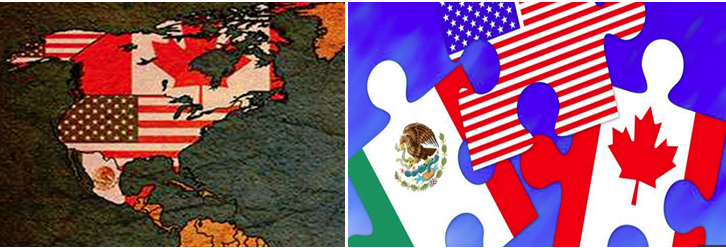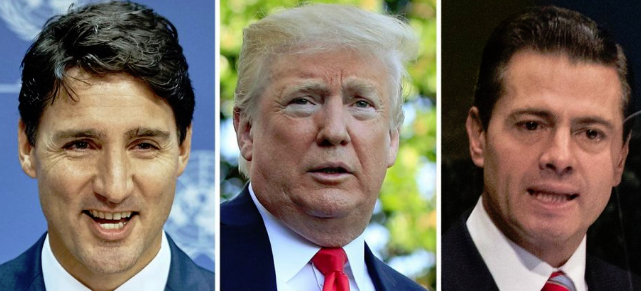|

USMCA - New trade deal between the US, Canada, and Mexico
|
Trump, Trudeau, and Peña Nieto agreed USMCA. It isn’t quite a “brand new deal, basically an updated version of the nearly 25-year-old trade agreement, with major changes on cars and new policies, on labor and environmental standards, intellectual property protections, and some digital trade provisions.
This deal will be the most modern, up-to-date and balanced trade agreement in the history of our country, with the most advanced protections for workers ever developed,” Trump said in a speech.
Experts say the changes are significant. The goal is to boost auto parts manufacturing in North America by forcing car companies to use parts made here versus cheaper parts from Asia. This will probably increase the cost of cars and trucks, and it might make it harder for Mexico to make or sell certain smaller cars here in the US.
The most striking difference from NAFTA involves protections for workers in all three countries.
The new agreement calls for 40 to 45 percent of automobile content to be made by workers who earn at least $16 an hour by 2023. This provision specifically targets Mexico and is meant to bring wages there up to US and Canadian standards.
That’s good for Mexican workers, but that’s not the only motivation behind it. The Trump administration hopes that if Mexico no longer pays its
|
|
workers a lot less than the US and Canada do, companies will no longer have a reason to move their factories there (and out of the US), thus keeping manufacturing jobs in the US and Canada.
In addition, Mexico has agreed to pass laws giving workers the right to real union representation, to extend labor protections to migrants workers (who are often from Central America), and to protect women from discrimination.
And unlike NAFTA, the new deal allows each country to sanction the others for labor violations that impact trade. It’s a complex, multi-step process modeled after similar protections in the Trans-Pacific Partnership (TPP), a multinational trade deal that Trump pulled the US out after taking office.
Since the approval process will take some time, most of the new USMCA provisions won’t go into effect until 2020.
Canada uses what’s called a supply management system for dairy (and eggs and poultry), which closely regulates how much of each product. can be produced and places strict tariffs and quotas on those items when they’re shipped into the country.
The US got Canada to open up its dairy market. Canada also agreed to eliminate Class 7 milk, which made it cheaper to buy certain high-protein milk products from domestic producers in Canada; US farmers complained that it blocked their
|
|
ability to export their products to Canada. But it will make a difference to some farmers in places like Wisconsin.
The USMCA aims to fix that by adding new provisions to deal with the digital economy — that is things like e-commerce and data. These new digital provisions include things like no duties on products purchased electronically, such as music or e-books, and protections for internet companies so they’re not liable for content their users produce.
Most of the provisions won’t go into effect until 2020, so it will be a while until American (or Canadian or Mexican) consumers and workers experience the effects of the new NAFTA.
It’s likely that American consumers will eventually pay a bit more for cars as a result of the deal, and while the administration’s goal is to keep manufacturing jobs in the US, it’s too early to predict what
|
|
the consequences on the work force will be.
American agriculture, in general, does very well under the new deal. American dairy farmers are celebrating. Canadian farmers aren’t thrilled, but Canadian consumers could benefit, not just on dairy but also on things such as online shopping and wine.
Finally, the new labor provisions mean that Mexican workers stand to benefit, with greater workplace protections and possibly higher wages.
In the meantime, debates in Canada, Mexico, and the US will play out over the following months about whether these revisions are wins or losses — and whether this new trade agreement is a real improvement on what came before.
The agreement needs to be ratified by all three governments. Mexico is the most dependent., so it has the most to lose. Incoming leftist
|
|
president Andrés Manuel López Obrador had already said, he won’t renegotiate the deal, and his backing will likely ease USMCA through Mexico.
In U.S both Democrats and Republicans supported a trilateral agreement.
Many of the more forward-looking agreements, such as digital trade protections and to boost auto parts manufacturing in North America.
The deal is also subject to a review every six years, at which point the US, Mexico, and Canada can decide to extend USMCA.
The question is how long this strategy can last, and whether it will work on harder trade deals, for instance with Japan and the European Union.
“Now every country is going to learn from this. If they can do, we can too.” Compiled by Ujjual
|

|
|
